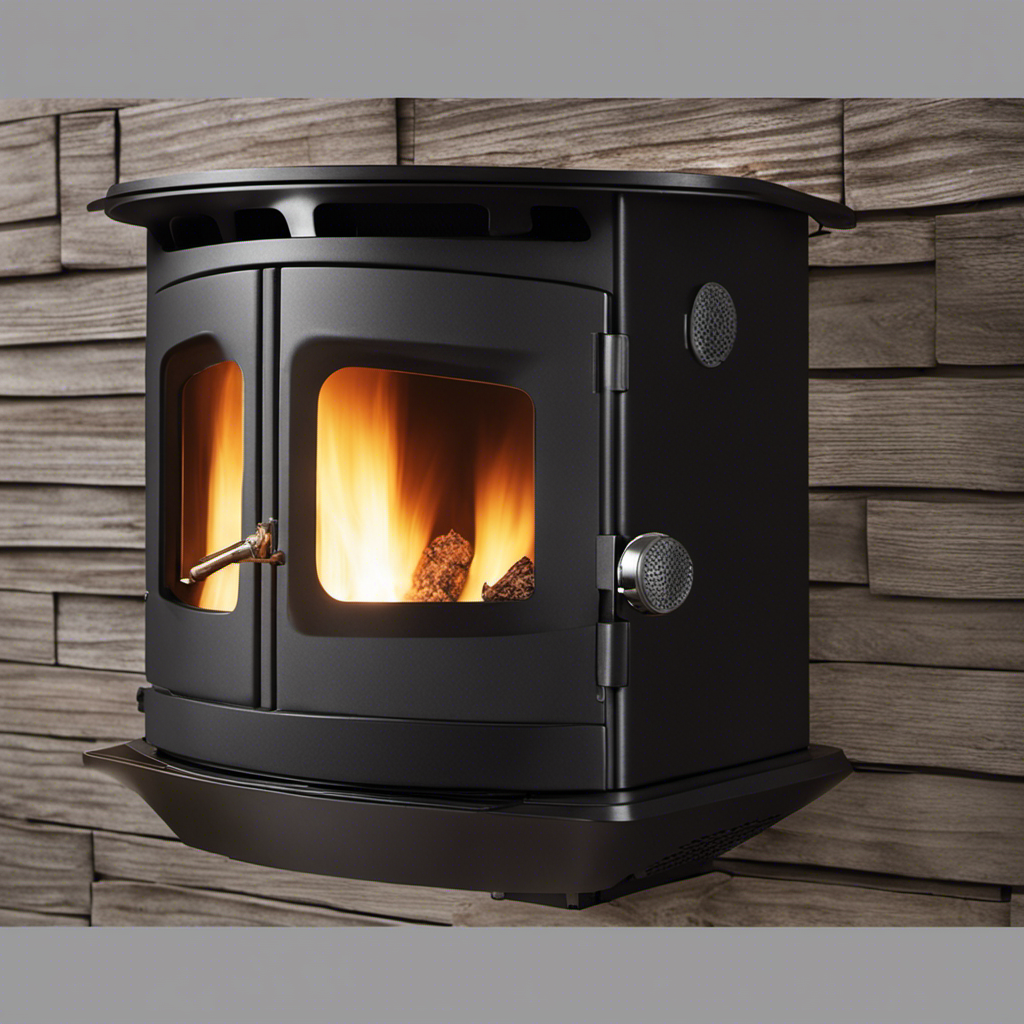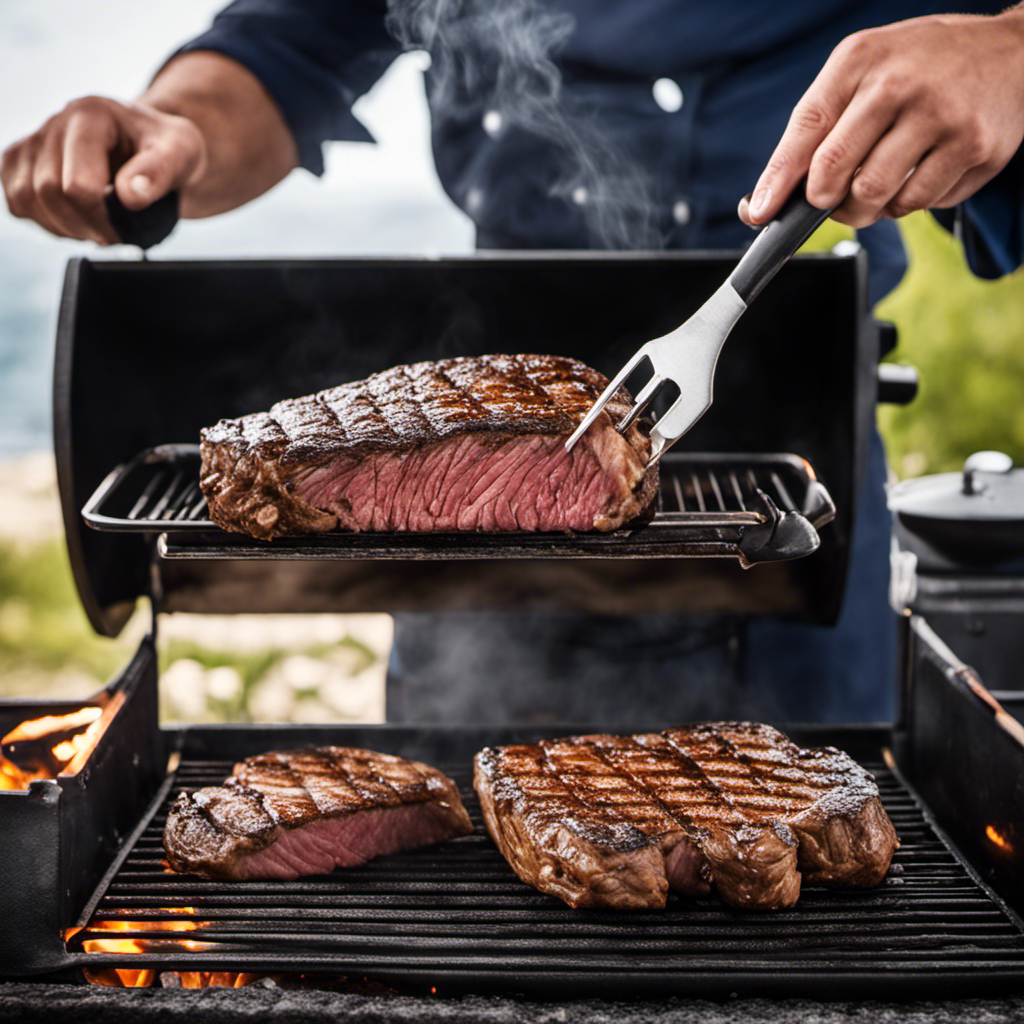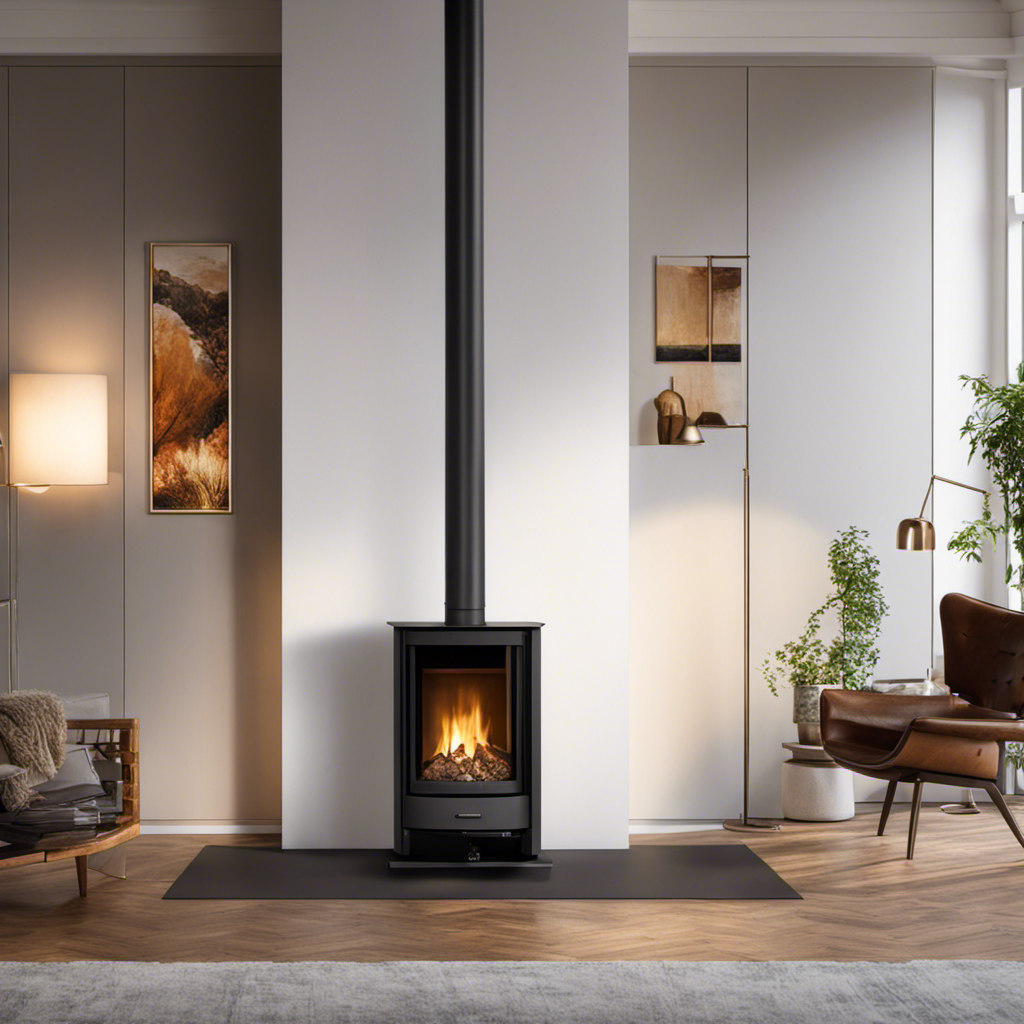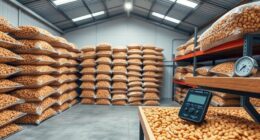I have always been fascinated by the operation of wood pellet mills and the intricate process they entail.
One example that comes to mind is a case study I recently came across. In this study, a wood pellet mill was able to efficiently grind and dry the wood material, pelletize it, and then cool and screen the resulting wood pellets.
The entire process was seamless and resulted in high-quality wood pellets that were ready for packaging and storage.
In this article, I will delve into the technical details of how wood pellet mills work and explore the environmental benefits they provide.
Key Takeaways
- Wood pellet mills grind wood into sawdust and compress it into small pellets.
- Different types of pellet mills, such as flat die mills and ring die mills, determine the efficiency and quality of the pellets.
- Wood pellets have high energy density, low moisture content, and reduced greenhouse gas emissions, making them an attractive option for renewable energy.
- The raw materials for wood pellet mills, such as sawdust, wood chips, and wood shavings, are obtained from sustainable sources and contribute to the reduction of waste and reliance on fossil fuels.
The Process of Wood Pellet Production
The process of wood pellet production involves several steps. First, wood is ground into sawdust. Next, the sawdust is compressed into small pellets. After that, the pellets are cooled and packaged for distribution. The design of pellet mills is important in determining the efficiency and quality of the pellets. There are different types of pellet mills available, such as flat die and ring die designs. Flat die mills are commonly used for small-scale production, while ring die mills are preferred for large-scale operations due to their higher capacity and durability.
Wood pellets have many advantages as a biomass energy source. They have a high energy density, low moisture content, and reduced greenhouse gas emissions compared to traditional fossil fuels. These qualities make wood pellets an attractive option for renewable energy.
Now, let’s discuss the raw materials used in wood pellet mills. These raw materials are crucial for producing high-quality pellets.
Raw Materials for Wood Pellet Mills
When it comes to wood pellet production, understanding the common raw materials used is crucial. These materials typically include sawdust, wood chips, and wood shavings, which are obtained from various sources such as sawmills, woodworking factories, and furniture manufacturers.
The pellet production process then involves grinding and drying the raw materials before compressing them into pellets, resulting in a highly efficient and sustainable fuel source.
Additionally, the use of wood pellets offers numerous environmental sustainability benefits, including reduced greenhouse gas emissions and reliance on fossil fuels, making it an attractive alternative for both residential and industrial heating.
Common Raw Materials
You can use different types of biomass, such as sawdust, wood chips, or agricultural waste, as raw materials for wood pellet mills. These materials are commonly used in wood pellet production techniques due to their availability and suitability for the process.
Sawdust, which is a byproduct of woodworking, is a popular choice because of its high lignin content, which acts as a natural binder during pelletization. Wood chips, on the other hand, are larger pieces of wood that can be obtained from logging or sawmills. Agricultural waste, including straw, corn stalks, and sugarcane bagasse, can also be used as raw materials.
These alternative uses for raw materials not only reduce waste but also contribute to the sustainability of the pellet production process. This ensures that the wood pellet industry remains environmentally friendly and economically viable.
Transitioning into the subsequent section about the "pellet production process," it is important to understand the various steps involved in turning these raw materials into wood pellets.
Pellet Production Process
Using biomass materials, such as sawdust, wood chips, or agricultural waste, can be a sustainable and environmentally friendly way to produce wood pellets. One of the major benefits of using wood pellets as a renewable energy source is their high energy density. Wood pellets have a higher energy content per unit mass than other biomass fuels, making them more efficient and cost-effective.
Wood pellet mills play a crucial role in the production process. These mills use specialized machinery to compress the biomass materials into compact pellets. The process involves grinding, drying, and pelletizing the raw materials, which are then cooled and packaged for use. Wood pellet mills can produce large quantities of pellets in a short period, making them a reliable and efficient fuel source.
Transitioning to the subsequent section about environmental sustainability benefits, the production of wood pellets helps reduce greenhouse gas emissions and dependence on fossil fuels.
Environmental Sustainability Benefits
The high energy density of wood pellets makes them an efficient and cost-effective renewable energy source. Here are four reasons why wood pellets contribute to environmental sustainability and the reduction of carbon emissions:
-
Renewable Energy Source: Wood pellets are made from sustainably sourced wood, such as sawdust and wood chips, which are byproducts of the timber industry. By utilizing this otherwise wasted material, we are reducing our reliance on non-renewable fossil fuels.
-
Carbon Neutral: When wood pellets are burned, they release carbon dioxide, but the amount emitted is equal to the carbon absorbed by the trees during their growth. This creates a carbon-neutral cycle, minimizing the net increase of greenhouse gases in the atmosphere.
-
Lower Emissions: Wood pellet combustion produces significantly fewer emissions compared to traditional fossil fuels like coal. This helps to improve air quality and reduce the overall carbon footprint.
-
Waste Reduction: Wood pellets are manufactured from wood waste, diverting it from landfills and reducing the environmental impact of waste disposal.
Transition: To produce wood pellets, the first step involves grinding and drying the wood material.
Grinding and Drying the Wood Material
In the grinding process, wood material is broken down into smaller particles to facilitate the pelletizing process. This involves the use of a hammer mill, which uses rotating hammers to strike and grind the wood.
Wood drying is a crucial step in the pellet production process as it reduces the moisture content of the wood material, making it easier to grind and improving the overall quality of the pellets produced.
Grinding Process Explained
To understand how wood pellet mills work, you’ll want to know about the grinding process. This crucial step in the production of wood pellets involves reducing the raw material into a fine powder. Here are the grinding techniques used in pellet mills to ensure optimal pellet mill efficiency:
-
Hammer mills: These machines use rotating hammers to pulverize the wood material, resulting in a consistent and uniform particle size.
-
Knife mills: Equipped with sharp blades, knife mills cut the wood into small pieces, ensuring a homogeneous and efficient grinding process.
-
Impact mills: By utilizing high-speed rotating blades or hammers, impact mills shatter the wood material into fine particles, enhancing the overall pellet mill efficiency.
The grinding process is vital in preparing the wood material for pellet production, but it is closely connected to the subsequent step – wood drying. Properly dried wood ensures optimal pellet quality and combustion efficiency.
Importance of Wood Drying
After the grinding process, it is crucial to ensure that the wood material has the right moisture content before it can be pelletized. Wood moisture refers to the amount of water present in the wood, and it plays a vital role in the pelletizing process. Wood with high moisture content is difficult to pelletize as it can lead to poor pellet quality and increased energy consumption during the pellet mill operation.
To reduce the wood moisture, various drying methods are employed. These methods include natural drying, kiln drying, and air drying. Natural drying involves exposing the wood to the sun and wind, while kiln drying utilizes heat and controlled humidity levels to remove moisture. Air drying involves stacking the wood and allowing air to circulate around it.
By reducing the wood moisture to the optimal level, the wood becomes more suitable for pellet production. It ensures that the pellets have the desired density and durability.
Now, let’s move on to the next section and explore the process of pelletizing the wood material.
Pelletizing the Wood Material
During the pelletizing process, the wood material is compressed and shaped into small pellets. Wood pellet density and the techniques used for pelletizing play a crucial role in determining the quality and efficiency of the final product.
Achieving the desired wood pellet density requires carefully selecting the raw materials, which should have a suitable moisture content and particle size distribution. Pelletizing techniques such as pressure and heat are employed to soften the lignin in the wood, allowing it to bind the particles together.
The compressed wood material is then forced through small holes in a die, creating uniform pellets of the desired size and shape. These pellets are then ready for the next stage of the process, which involves cooling and screening to ensure their quality and readiness for use.
Cooling and Screening the Wood Pellets
You can ensure the quality of the wood pellets by carefully cooling and screening them. Cooling efficiency is crucial in maintaining the integrity and durability of the pellets. Here are two methods to achieve optimal cooling:
-
Air Cooling:
-
The hot wood pellets are transferred to a cooling chamber.
-
Cold air is blown over the pellets, removing excess heat.
-
The cooled pellets are then ready for screening.
-
Water Cooling:
-
The wood pellets are submerged in a water bath.
-
The water absorbs the heat from the pellets, rapidly cooling them.
-
The pellets are then separated from the water and proceed to the screening stage.
Screening methods further enhance the quality of the wood pellets by removing any fines or oversized particles. This ensures uniform size and consistency, improving combustion efficiency.
Now, let’s delve into the next section, where we will explore the packaging and storage of wood pellets.
Packaging and Storage of Wood Pellets
The packaging and storage of wood pellets is crucial for maintaining their quality and preventing moisture damage.
One of the main concerns when it comes to packaging challenges is ensuring that the pellets are sealed properly to keep out any moisture. Moisture can lead to the degradation of the pellets, causing them to crumble or mold. To address this issue, storage solutions such as using waterproof bags or containers with airtight seals are commonly employed.
Additionally, it is important to store wood pellets in a dry and well-ventilated area to further prevent moisture build-up. Proper labeling and stacking techniques are also essential to ensure efficient storage and easy identification.
By implementing these packaging and storage solutions, the quality of wood pellets can be preserved, ultimately leading to better performance and customer satisfaction.
Transitioning into the subsequent section about the maintenance and troubleshooting of wood pellet mills, it is equally important to ensure the proper functioning and upkeep of the machinery to produce high-quality pellets.
Maintenance and Troubleshooting of Wood Pellet Mills
To keep your wood pellet mill running smoothly, regular maintenance is essential. Proper maintenance techniques can help prevent breakdowns and ensure optimal performance of your mill.
One important maintenance task is cleaning the mill regularly to remove any dust, debris, or foreign objects that may accumulate and cause clogging or damage.
Lubricating the moving parts, such as the rollers and bearings, is also crucial to reduce friction and extend the lifespan of these components.
Additionally, regularly inspecting the electrical connections and replacing worn-out or damaged parts can help prevent electrical issues and improve safety.
Troubleshooting tips can also be helpful in addressing common problems, such as uneven pellet size or low production rates.
By following these maintenance techniques and troubleshooting tips, you can maximize the efficiency and lifespan of your wood pellet mill.
Transition: In addition to the maintenance and troubleshooting aspects, wood pellet mills also offer significant environmental benefits.
Environmental Benefits of Wood Pellet Mills
In addition to their maintenance and troubleshooting aspects, wood pellet mills also have significant environmental benefits. Here are three reasons why wood pellet mills are considered an environmentally-friendly choice:
-
Reducing Carbon Emissions: Wood pellets are made from renewable biomass sources such as sawdust, wood chips, or agricultural waste. When burned as fuel, they release significantly fewer greenhouse gas emissions compared to fossil fuels like coal or oil. This helps to reduce the overall carbon footprint and combat climate change.
-
Renewable Energy Source: Wood pellets are derived from sustainable forestry practices, where trees are responsibly harvested and replanted. Unlike fossil fuels, which are finite resources, wood pellets offer a renewable energy source that can be continuously produced and utilized without depleting natural resources.
-
Waste Reduction: Wood pellet mills help to repurpose and utilize wood waste that would otherwise end up in landfills. By converting this waste into valuable fuel, wood pellet mills contribute to waste reduction and promote a more circular economy.
Overall, wood pellet mills play a crucial role in reducing carbon emissions, providing a renewable energy source, and minimizing waste, making them an environmentally-friendly option for meeting energy needs.
What is the process of making wood pellets in a wood pellet mill?
At wood pellet mill processes, raw materials like sawdust or wood chips are first ground into small particles. Then, the particles are fed into the wood pellet mill where they are compressed and heated to form pellets. The pellets are then cooled and screened before being ready for use.
What Are the Key Components of a Wood Pellet Mill and How Do They Function?
A wood pellet mill operation consists of several key components including the hammer mill for grinding raw materials, the pellet machine for compressing the materials into pellets, and the cooler and dryer for reducing moisture content. The final step involves the packaging machine for storing and transporting the finished wood pellets.
Frequently Asked Questions
Are Wood Pellets Safe to Use for Heating and Cooking?
Yes, wood pellets are safe to use for heating and cooking. They have environmental benefits and are cost-effective compared to other options. They provide efficient heat and are a renewable energy source.
How Long Do Wood Pellet Mills Typically Last?
Wood pellet mills typically last for several years, with the longevity depending on various factors such as maintenance, usage, and quality of the machine. These factors can significantly affect the lifespan of wood pellet mills.
Can Wood Pellet Mills Use Different Types of Wood as Raw Materials?
Different types of wood suitable for wood pellet production include hardwoods, softwoods, and agricultural residues. Benefits of using different types of wood in wood pellet mills include increased energy efficiency and reduced emissions.
What Is the Average Production Capacity of a Wood Pellet Mill?
On average, a wood pellet mill can produce around [insert production capacity] of wood pellets per hour. This production capacity is determined by the size and efficiency of the mill.
Are There Any Regulations or Certifications for Wood Pellet Mills to Ensure Their Quality and Environmental Impact?
Yes, there are regulations and certifications for wood pellet mills to ensure their quality and minimize their environmental impact. These measures are in place to promote sustainable practices and protect the environment.
Conclusion
So there you have it, folks. Wood pellet mills, the magical machines that turn wood into little nuggets of fuel. It’s truly a fascinating process.
From grinding and drying the wood material to pelletizing it and finally cooling and screening the wood pellets. And let’s not forget about the packaging and storage, because who doesn’t love a neatly packed bag of wood pellets?
But the real star of the show is the maintenance and troubleshooting of these mills, because let’s face it, nothing is perfect. But fear not, because the environmental benefits of wood pellet mills make it all worth it.
So next time you cozy up by the fire, remember the humble wood pellet mill that made it all possible.











